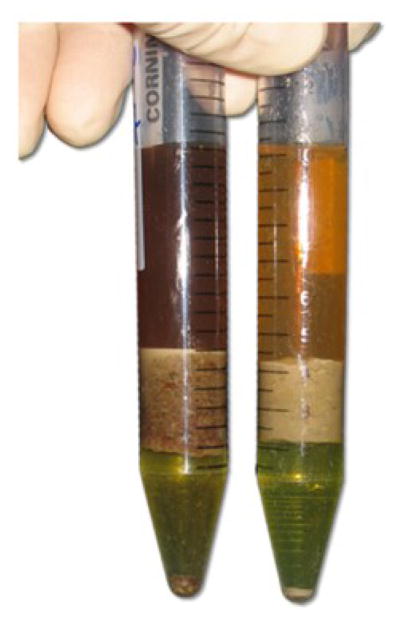Abstract
The analysis of feces composition is important for the study of energy metabolism, which comprises various measurements of energy intake, energy expenditure, and energy wasting. The current protocol describes how to measure energy-dense lipids in mouse feces using a modification of the method proposed by Folch et al. (1957).
Materials and Reagents
Mouse feces
Normal saline (about 5–10 ml per mouse, depending on the amount of feces) (e.g., Sigma-Aldrich)
Chloroform in methanol (2:1 by volume) (about 5–10 ml per mouse)
Equipment
Forceps suitable for picking up mouse feces
Sieve, coarse enough to hold back mouse feces
Optional: Flour sifter
50-ml and 15-ml conical polypropylene tubes (one of each per mouse)
15-ml glass tubes (one per mouse)
Tube stands
Analytical balance
Chemical fume hood
Potter-Elvehjem tissue grinder and drill
Centrifuge with rotor to hold 15-ml tubes (e.g., Beckman Coulter GS-6 with GH-3.8 swing bucket rotor or similar)
22G 1½ hypodermic needles (two per mouse)
5-ml syringes (one per mouse)
Procedure
A. Collect mouse feces
-
1
Replace bedding in all of the mouse cages. It is best to use bedding material that consists of small particles; you may want to ask your local animal facility for available choices.
-
2
Feed the mice (one per cage) ad libitum for a number of days (e.g., 3–4 days).
-
3
Place the mice in new cages.
-
4
Run the bedding in the old cages over a coarse sieve that holds back feces and other large particles.
-
5
Optionally, run the feces and other particles over the flour sifter.
-
6
Using the forceps, pick up all the feces from one mouse and place it in a 50-ml conical tube that is labeled with the mouse number. Repeat for all mice.
-
7
Obtain the total feces weight per mouse.
-
8
Weigh exactly 1,000 mg of feces per mouse and powderize it using the tissue grinder.
B. Prepare glass tubes
-
9
Label each glass tube with a corresponding mouse number.
-
10
Weigh the tube on an analytical balance; make a note of the tube number and weight.
C. Extract the lipids
-
11
Add 5 ml of normal saline to 1,000 mg of powderized feces in a 15-ml tube and vortex.
-
12
Add 5 ml of chloroform: methanol mix and vortex.
-
13
Centrifuge the suspension at 1,000 x g (about 2,000 rpm with above-mentioned rotor) for 10 min at room temperature. Afterwards you will see two liquid phases that are separated by a solid phase (Figure 1); there may be another, small solid phase at the bottom. The lower liquid phase contains the extracted lipids in chloroform: methanol.
-
14
Holding the plastic tube above a glass tube, carefully insert a 22G½ needle through the tube wall into the lower of the two liquid phases; then, remove the needle. Caveat: Potential hazard: When inserting needles into the plastic tubes, make sure to apply gently, constant pressure. Twisting the needle may facilitate the insertion. Do not keep your fingers at the opposite wall of the tube!
-
15
Attach an air-filled syringe to another 22G½ needle; carefully insert the needle at the top of the lower of the two liquid phases, just below the solid phase (Video 1).
-
16
Hold the tube above the glass tube that is labelled with the mouse’s number and carefully inject the air; the lower liquid phase will be drained from the plastic tube and be collected into the glass tube.
Figure 1. Two samples of dissolved feces after centrifugation.
The figure shows the three layers after centrifugation of feces suspended in chloroform: methanol. Phase ‘1’ is the aqueous phase. Phase ‘2’ contains insolubles. Phase ‘3’ contains the extracted lipids.
Video 1. Removal of lipid phase from plastic tube.
The video shows how to insert a needle into the polypropylene tube and drain the lipid phase from the tube.
D. Evaporation
-
17
Place the glass tubes in a stand under a fume hood.
-
18
Leave the tubes alone for 3–4 days until all liquid is evaporated.
-
19
Weigh the tubes on the analytical balance.
-
20
Subtract the empty tube weights from the new tube weights to obtain the lipid mass per 1,000 mg of feces.
-
21
Multiply the lipid mass by the total weight of feces in grams, and divide it by the number of days that the feces were collected for to obtain the mouse’s average fecal lipid excretion per day.
Notes
In the authors’ hands, 12-week-old male C57BL/6 mice fed with standard chow (LabDiet Formulab 5008) excrete 5.8 ± 0.5 [SD] grams of feces and 8.6 ± 4 mg of fecal lipids per day (lipid content in feces, 6 ‰). On a high-fat diet (Harlan Teklad TD 93075), they excrete 2.5 ± 0.4 grams of feces and 10.0 ± 1.4 mg of fecal lipids per day (lipid content in feces, 19 ‰).
Acknowledgments
This protocol (Kraus et al., 2014) is based on a method reported by Folch et al. (1957). The work was by supported grants from the Deutsche Forschungsgemeinschaft (KR 3475/1-1) and American Heart Association (09POST2250499) to D.K., grants from the NIH (KO8 DK090149, R01 DK100385, BNORC P30 DK046200 and NORCH P30 DK040561) to Q.Y., and grants from the NIH (R37 DK43051, P30 DK57521) as well as a grant from the JPB foundation to B.B.K.
References
- 1.Folch J, Lees M, Sloane Stanley GH. A simple method for the isolation and purification of total lipides from animal tissues. J Biol Chem. 1957;226(1):497–509. [PubMed] [Google Scholar]
- 2.Kraus D, Yang Q, Kong D, Banks AS, Zhang L, Rodgers JT, Pirinen E, Pulinilkunnil TC, Gong F, Wang YC, Cen Y, Sauve AA, Asara JM, Peroni OD, Monia BP, Bhanot S, Alhonen L, Puigserver P, Kahn BB. Nicotin-amide N-methyltransferase knockdown protects against diet-induced obesity. Nature. 2014;508(7495):258–262. doi: 10.1038/nature13198. [DOI] [PMC free article] [PubMed] [Google Scholar]



